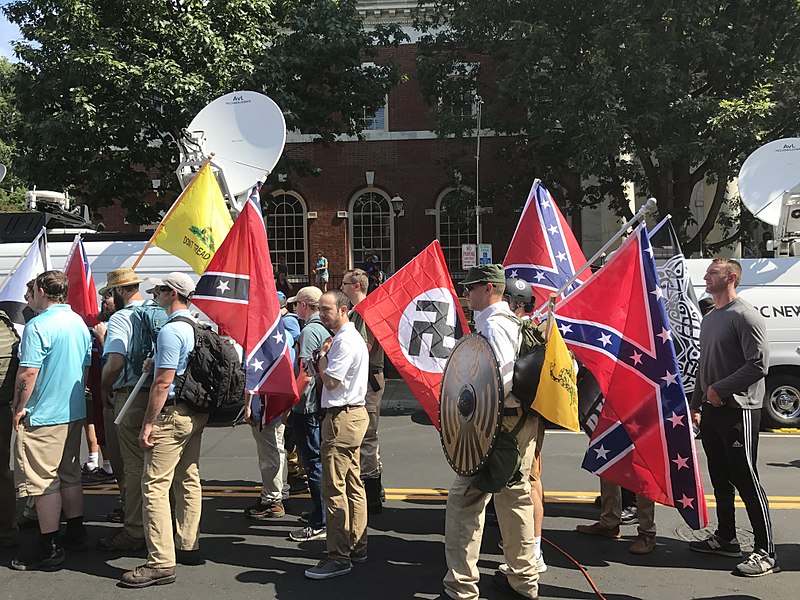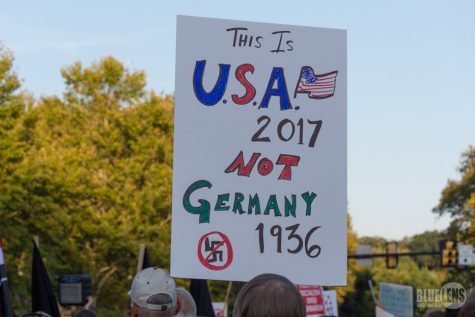Charlottesville: How far can the First Amendment go?
“Unite the Right” Rally in Charlottesville
In the US Bill of Rights, the very first amendment states that “Congress shall make no law… abridging the freedom speech, or of the press, or of the right of the people peaceably to assemble, and to petition the government for a redress of grievances.” This amendment is one of the foremost protections of our free and fair democracy, and yet it is can be the root of a common controversy within such a democracy- what are the limits to our freedom of speech, and when (if ever) can freedom of speech, press, and the right to peaceably assemble go too far? During August 11 and 12, as well as the ensuing weeks, this controversy would become the center of a national debate regarding the events of the Charlottesville Rally.
The ‘Unite the Right’ rally scheduled for August 12 in Emancipation Park, Charlottesville, was not the first event of its kind to take place there. May 13-14, 2017, saw the ‘Take Back Lee Park’ (Lee Park being the former name of Emancipation Park) rally in Charlottesville, in response to the city council’s decision to remove the Confederate statue of General Robert E. Lee (NBC29). Another rally in Charlottesville’s Justice Park took place on July 8, 2017, and was led by the Pelham N.C. KKK organization the Loyal White Knights. This rally was held to protest the same complaint as the ‘Take Back Lee Park’ event: the controversy regarding the planned removal of the confederate statue (http://time.com/4850427/ku-klux-klan-kkk-charlotesville-virginia-rally/). Therefore, it should not come as a surprise that there was yet another rally organized for August 2017, nor should it have been unexpected that there would be strong backlash; at both past rallies, counter protesters attended the initial event as well as counter-protests the following day. Nor was the possibility of violence unheard of, since there had been arrests made in May as well as in July for disorderly conduct and unlawful assembly (NYT) (NBC29).
However, neither rally had yet garnered the national eye, largely because the legal permits necessary for such events had been respected and the events were not of comparable size to the one which would take place in August. Neither had the issue of freedom of speech yet been broached with specific regard to those incidents, which can again be attributed to the lack of media attention and the scale of the events. It would take unprecedented (or perhaps predictable) violence in Charlottesville before America would be confronted with the controversy of Confederate memorabilia once again.
This violent confrontation began as nothing more than rumors regarding a possible kick off event that circulated Charlottesville the week leading up to the Unite the Right rally planned for Saturday, August 12. That Friday, well-known white supremacist leader Richard Spencer texted a reporter “I’d be near campus tonight, if I were you. After 9 pm. Nameless Field”. Right on time, the approximately 200 marchers were illuminated in the glow of their flaming torches, and the trek through University of Virginia began. Organizers drove on the columns of marchers on as chants of “Blood and soil!” and “Jews will not replace us!” filled the air; the procession was met with about 30 UVA students who had linked arms around the statue of Jefferson, the site of the march’s conclusion. Violence was brewing in the air as the marchers began to chant “White lives matter” and shout slurs at the students, which quickly escalated into skirmishes and full-blown fights. Chemicals were sprayed from both sides, and some marchers retaliated by throwing their torches at students (WP).
Friday night was only the kick off for the following day’s Unite the Right rally. The next morning, counter protesters and rally-goers alike began to assemble hours before the scheduled start time of noon. Both sides carried posters and banners, but many rally goers accessorized with weaponry as well. Long guns and pistols could be seen among the Unite the Right groups, while the counter protesters held shields or sticks. By 9:30 am, the tense atmosphere would be compounded by the addition of 30-40 members of a Unite the Right- supporting militia, who carried semiautomatic rifles and wore full camouflage. This militia was not welcomed by police, contrary to the claims of the group’s leader, Christian Yingling. Brian Moran, Virginia’s Secretary of Public Safety and Homeland Security, explained that “They seemed like they weren’t there to cause trouble, but it was a concern to have rifles in that kind of environment”. That kind of environment erupted around 11 am, when counter protesters blocked the path of an approaching group of rally goers and fights broke out, chemical irritants, swinging sticks, and punches thrown between both sides. Fights like these were breaking out across the entrances to Emancipation Park, as rally goers ignored a plan created by law enforcement to avoid potential clashes with counter protesters and by using one particular entrance. At 11:22 am, half an hour before the scheduled start time, an unlawful assembly was declared by police. As people began to leave Emancipation Park, insults were hurled between both sides, but it seemed that the worst of the violence and arrests had passed. A few hours later, the domestic terrorist attack which killed one woman and injured 19 others would prove this wrong (WP.)
On August 12, 2017, a 20-year-old man named James Alex Fields Jr. murdered a woman and injured 19 others. At 1:14 pm, he drove his grey Dodge Challenger into a crowd of counter protesters, then reversed into more people, and within just moments he fled the scene as bodies lay strewn in his wake. Later that day, two police officers were killed in a helicopter crash after carrying out surveillance on the rally. Fourteen more people were admitted to the hospital throughout the day for various non-life threatening injuries sustained from the rally. In total, the casualties number to be three dead, and 34 injured, five of whom admitted in critical condition (NYMAG).
Did police become involved too late? Should the state of emergency been declared sooner, and unlawful assembly been called earlier? Perhaps yes, perhaps no, but ultimately the biggest question which has emerged from the violence at Charlottesville remains to be how far the first amendment right to freedom of speech reaches, and what the impacts of that freedom can be. While a strong, just democracy relies upon the freedom of it’s constituents to participate in political discourse, it relies equally upon the safety of its constituents in doing so. Charlottesville illustrated the tragic results that can come from a faulty balance of safety and speech. It is up to America to redefine and reevaluate that balance.



Swarna Gowtham • Nov 26, 2017 at 7:17 pm
Very informative article. Peri is very skilled at stating the facts sequentially in which the audience understands how the situation escalated. She gives us insight to the quiet start of the Charlottesville rallies and then takes us on to the main events that readers get shocked by. She states that the rally started out as a small rumor but then escalated to crowds of people that started shouting racial slurs. Even though journalistic writing is very different from essay writing, the idea of starting out small and saving the main stuff and the big stuff for further in is a very smart thing to do when writing articles. Its puts into perspective as to how these news breaking stories can start out as nothing but a town rumor. I also love how at the end of the article, Peri gives us questions to think about. When she asks “Did the police get involved to late?” (Munter), it gives the readers something to think about after they have digested the gist of the story. Questions help readers to form opinions or think about something they hadn’t thought of before which is fantastic because I feel thats what journalists want from an audience, a reaction. Personally, I think that the first amendment right should stay in place as it is because our country simply cannot hold the title of being a free democratic nation if we are too afraid to let people say what they want too say. However what the government should do is firmly enforce that what one says comes with repercussions and if one decides to say or do something that is racially charged, law enforcers are going to reprimand that person for it. We should clearly tell people that if you attack university students based on prejudices, yes you do technically have the right to express that you hate jews but the constitution will not however protect you from law enforcement charging you with assault in the first degree or with a hate crime.